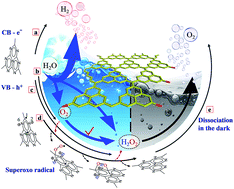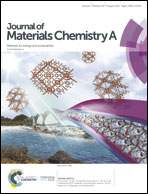An on-demand solar hydrogen-evolution system for unassisted high-efficiency pure-water splitting†
Abstract
Solar water splitting of pure water offers an attractive means for sustainable and carbon-free H2 production. However, current photocatalytic H2 production systems still suffer from two basic issues: the kinetic bottleneck for O2 release and the easy toxicity of the photocatalysts. Here, we developed a consolidated photocatalyst, namely g-C3N3.5(O0.5H0.5), that can boost sustainable and superior H2 evolution without using any sacrificial reagent. By conceptual design analysis as the guideline for three synthetic steps, the surface hydroxylation structure of g-C3N3.5(O0.5H0.5) concurrently increases the toxicity resistance and maximizes the charge separation for H2 evolution. The obtained surface-hydroxylated g-C3N3.5(O0.5H0.5) photocatalyst exhibited unassisted high-efficiency pure-water-splitting activity, with a benchmark H2-evolution rate up to 947.7 μmol h−1 g−1 under visible-light irradiation. Notably, the quantum efficiency of the g-C3N3.5(O0.5H0.5) suspension reached ∼10.6 and ∼2.5% at 420 and 520 nm, respectively, 10–20 times that of pristine g-C3N4. For the first time, we observed a key phenomenon that H2O molecules can rapidly capture the photoexcited holes to produce H2O2, which can greatly promote the efficient charge separation for high H2 evolution.

- This article is part of the themed collection: 2019 Journal of Materials Chemistry A HOT Papers


 Please wait while we load your content...
Please wait while we load your content...